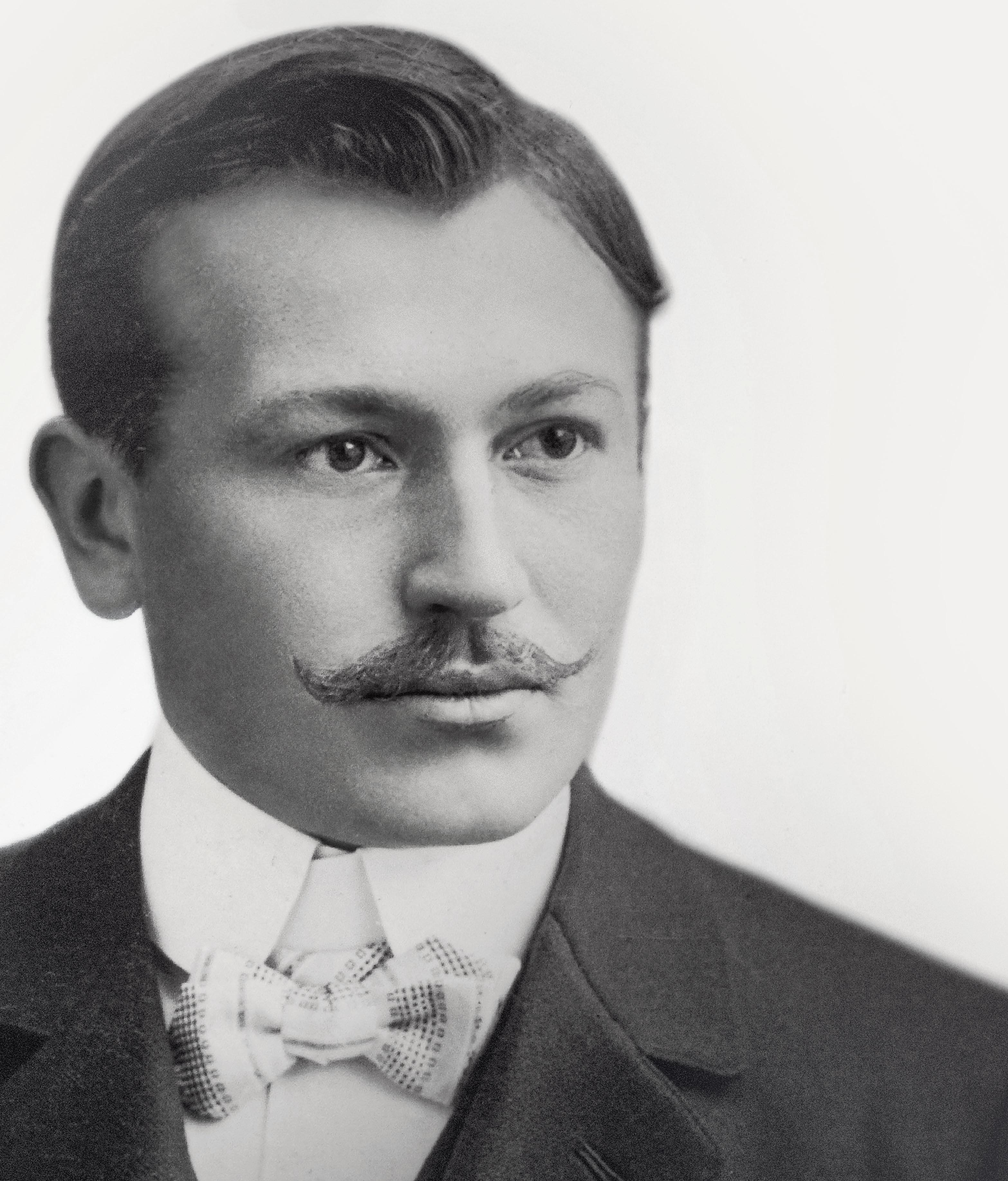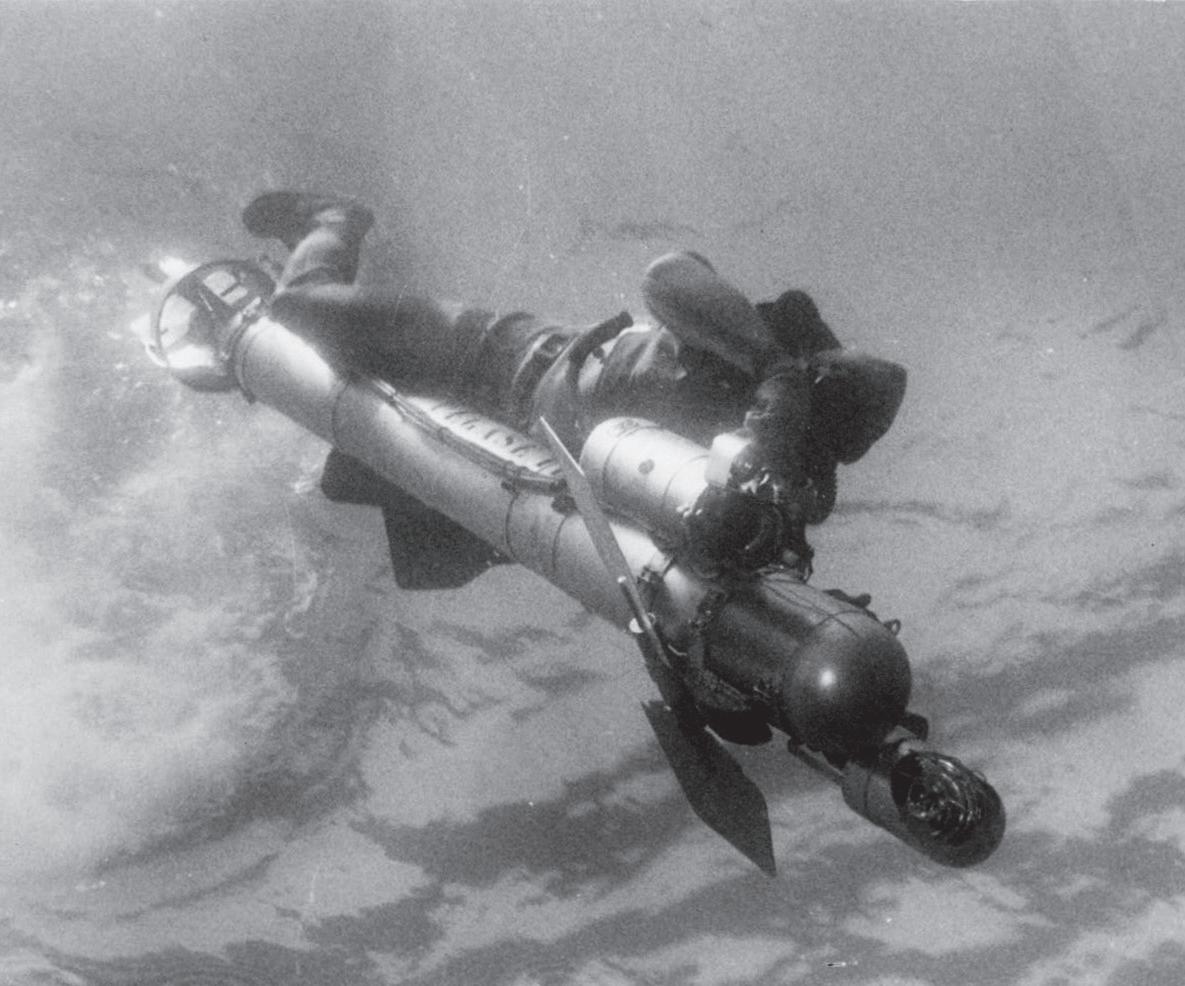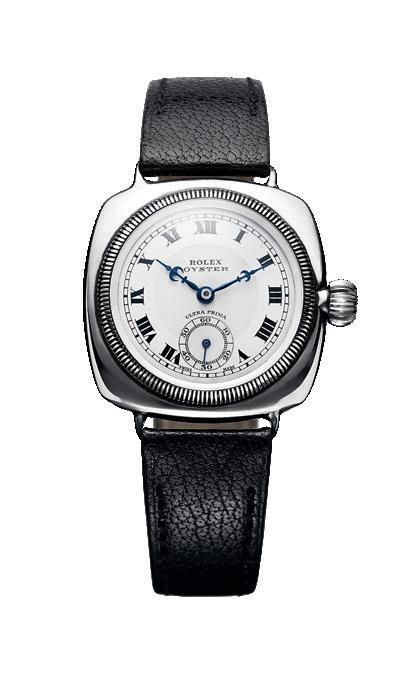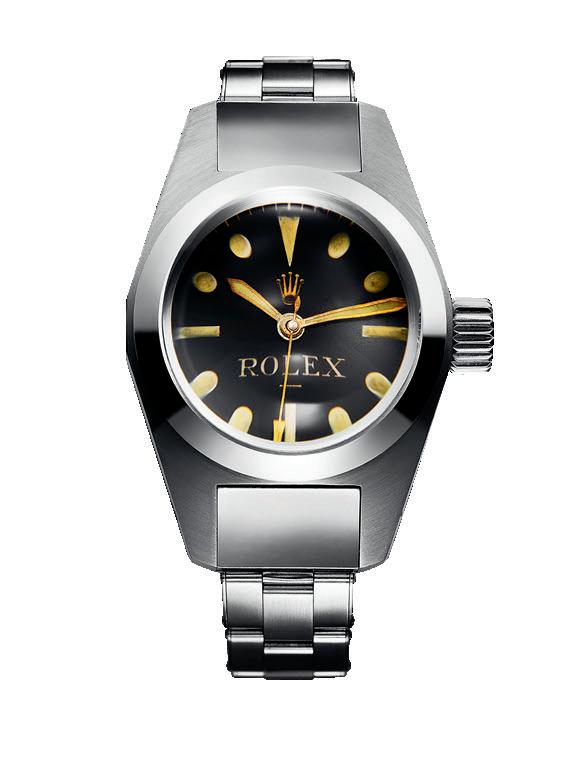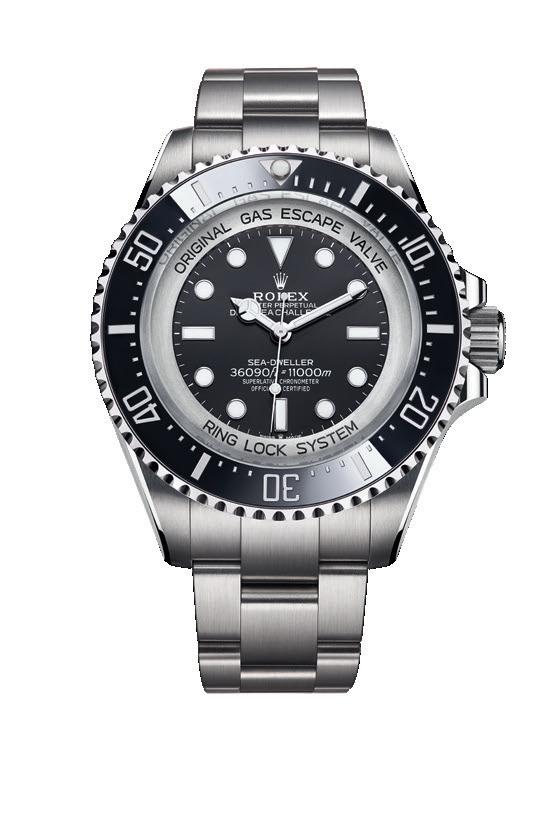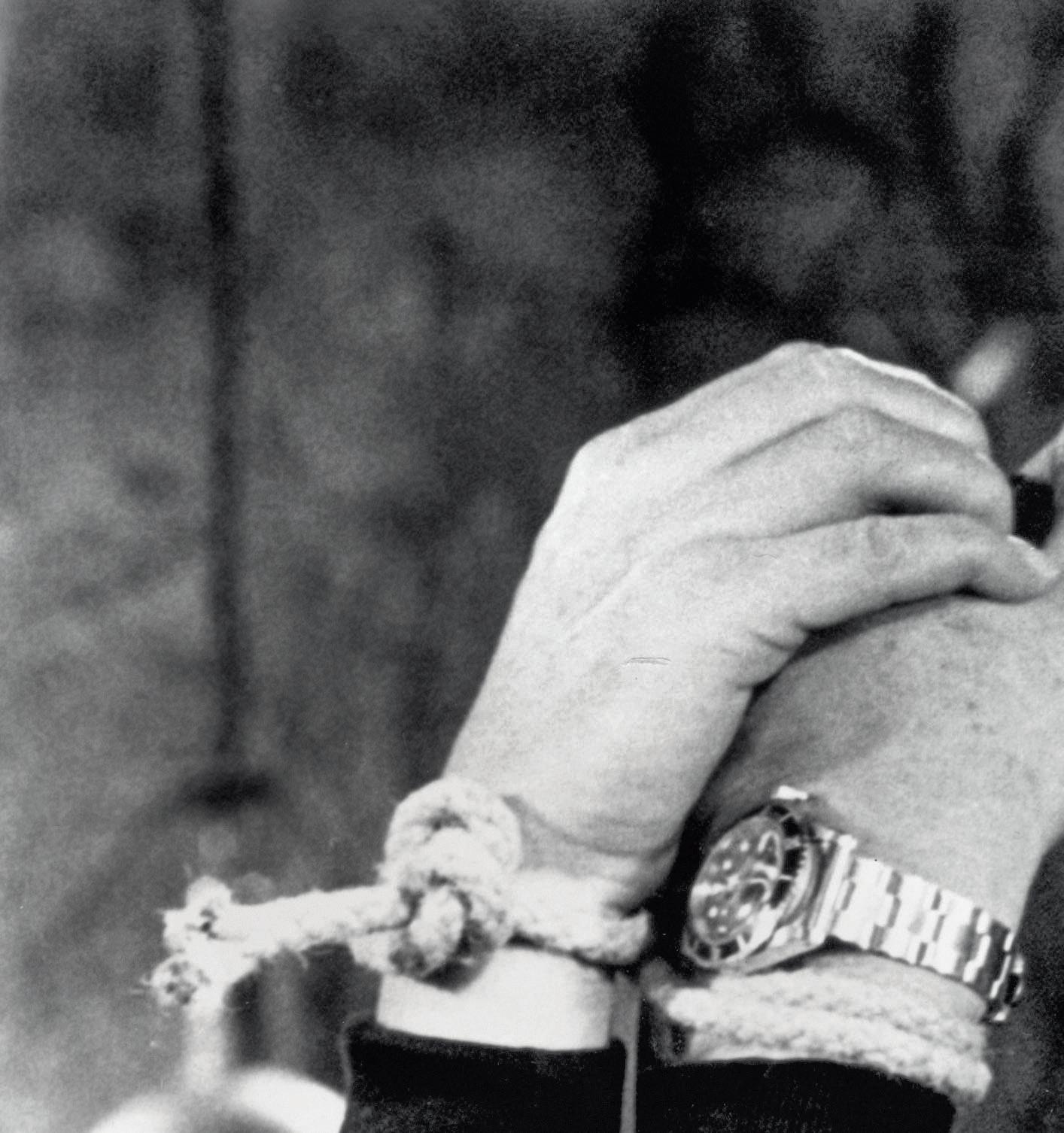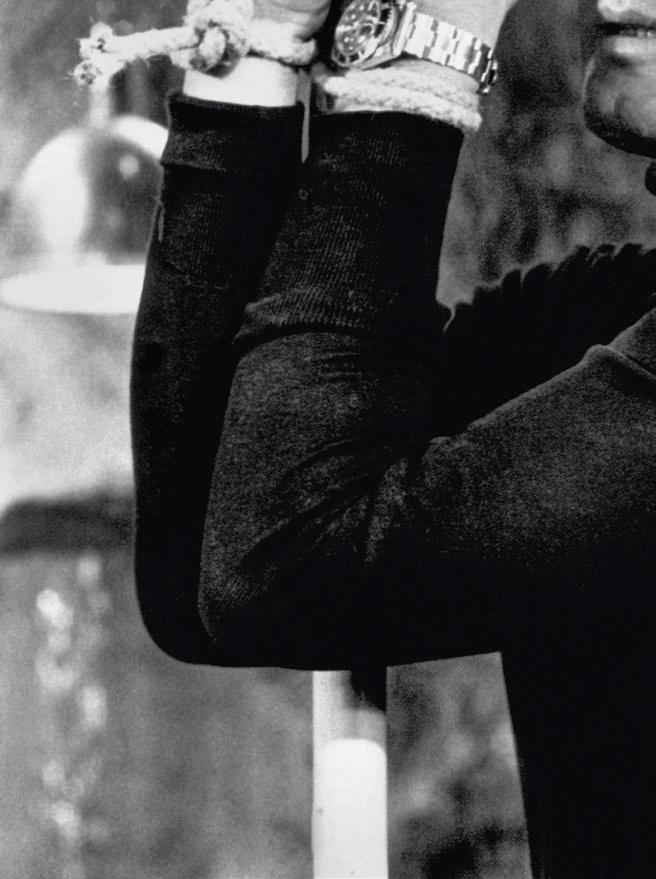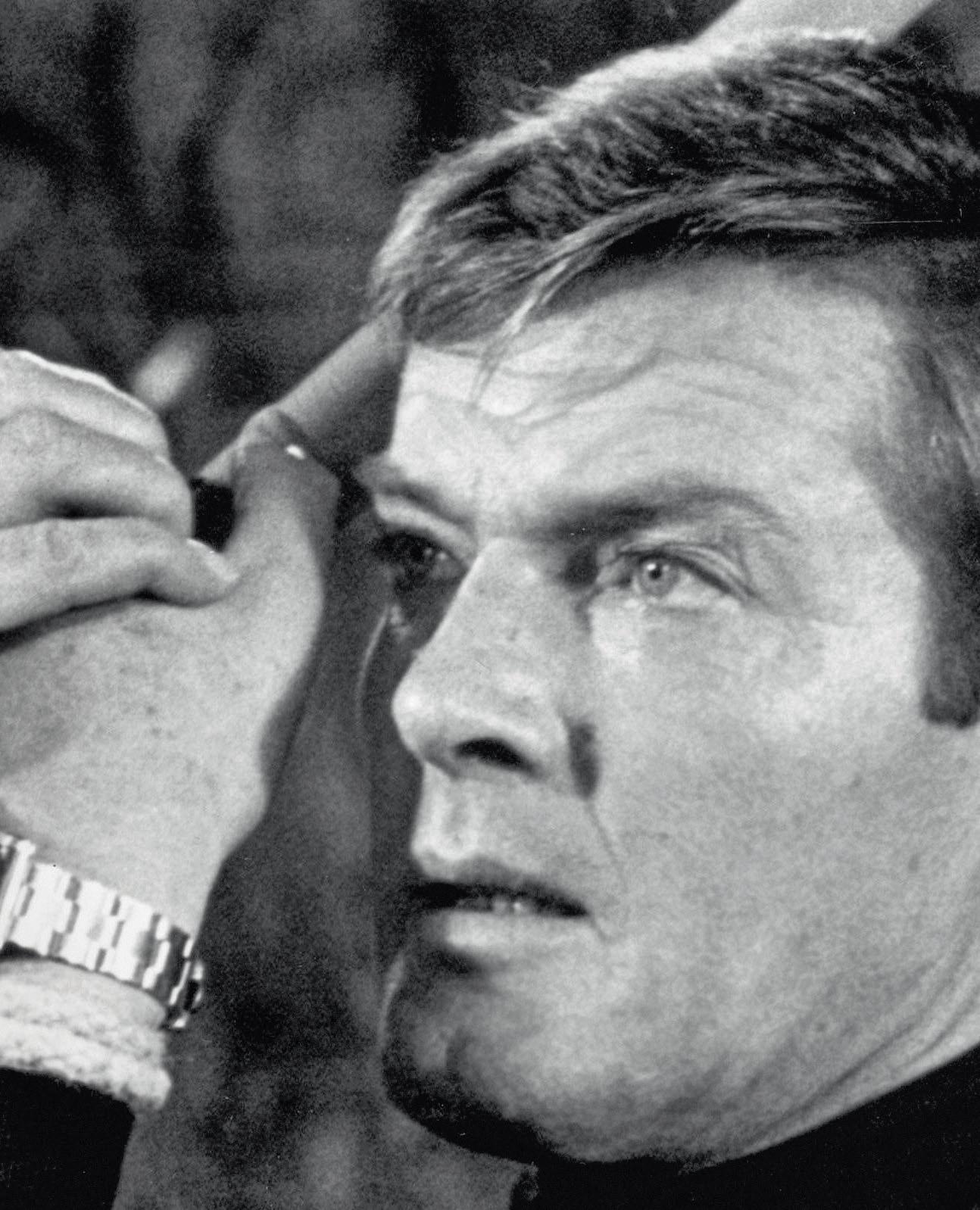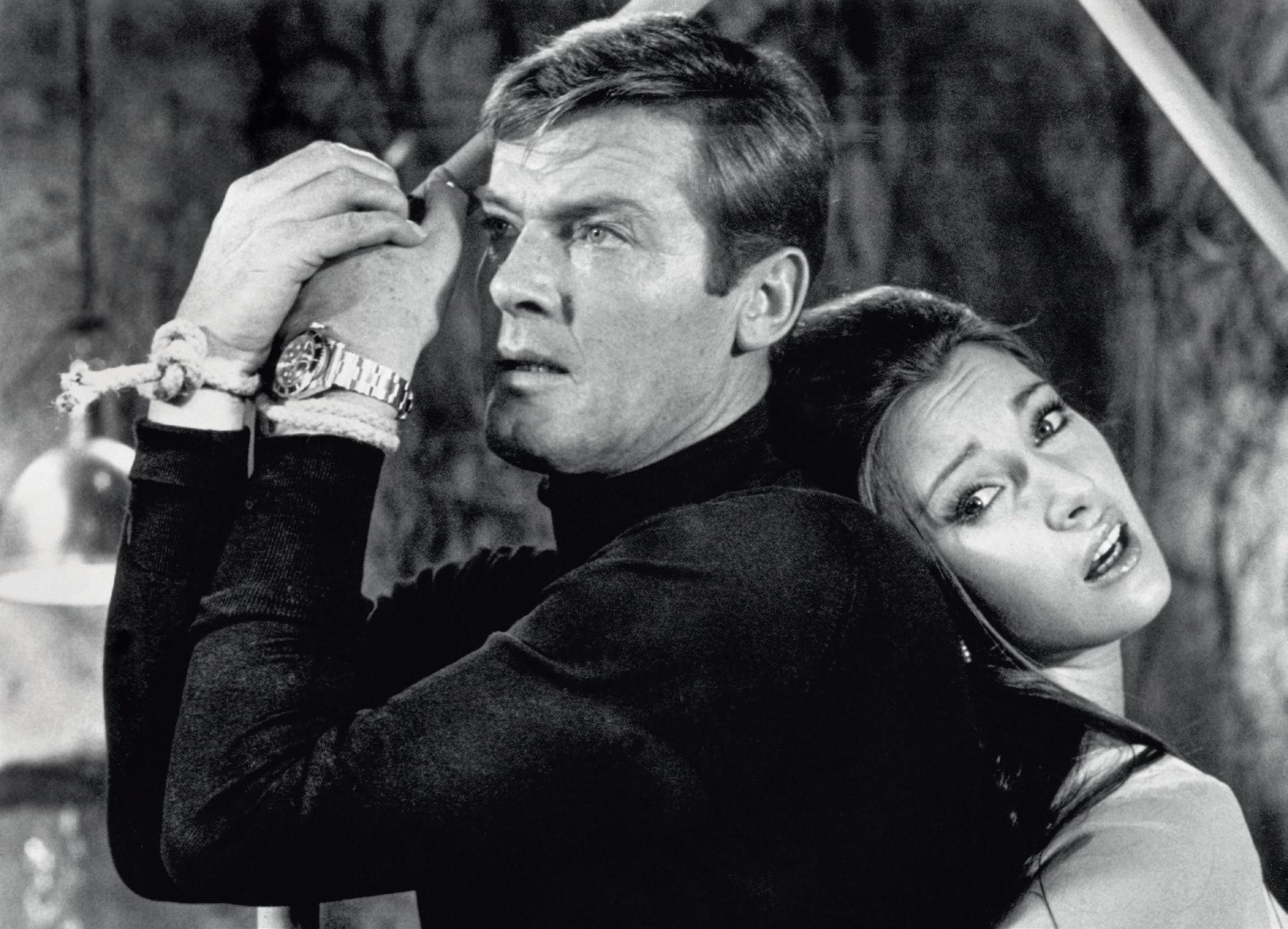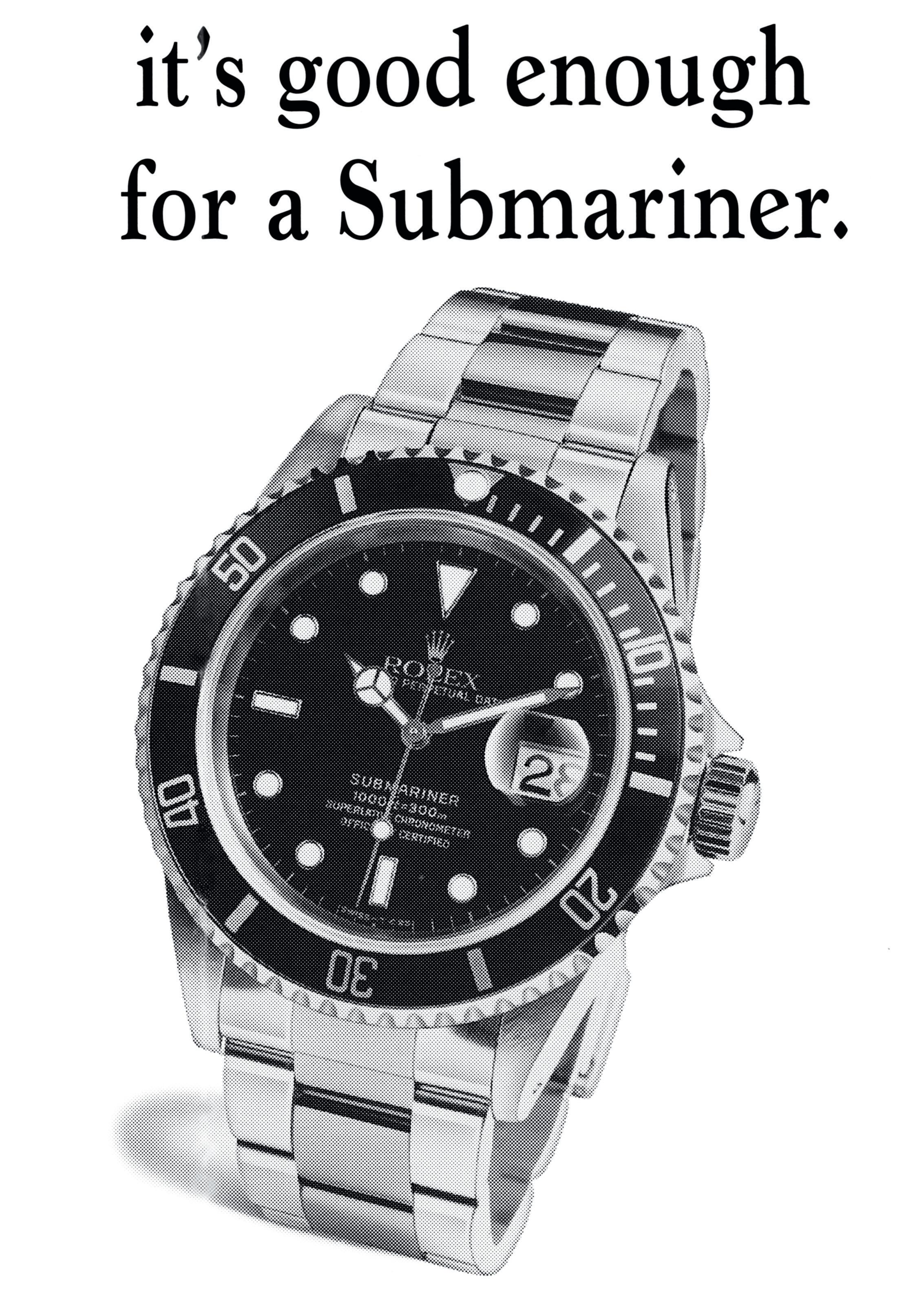A DIVER’S DREAM COME TRUE
Dear René, San Remo 12.1.1953
Your letter Re Mr Rebikoff is very interesting, and it seems to open fresh possibilities for Rolex becoming well known for our waterproof watches. The more we concentrate upon same the better for our future.1
I
n his letter to Jeanneret, Wilsdorf also ruminated over various names: “I like the name Deep Sea Special better than Frogman. I am sure that Nautilus is already registered.”2 Military divers were far from being the only human visitors to the world under the waves. Wilsdorf was now a man in his seventies. Nevertheless, he was as engaged as ever with the latest advances in technology, determined to create ever better watches to meet the needs of a rapidly developing world, and one of the most startling developments of the 1950s was the explosion in underwater exploration. Although the Submariner served the needs of the armed forces, its potential for civilian diving was immense, as Rolex realized from the outset. Men had been diving beneath the waves for millennia searching for pearls or sponges, and by the beginning of the 16th century, illustrations of primitive diving apparatuses began to appear in printed texts. In the early 19th century, a template was established that would alter little for well over a century: a bronze or copper spherical helmet, attached by a flexible collar to an airtight suit, fed with air
delivered by a pipe connected to a pump at the surface. One could either enjoy the mobility and relative freedom of swimming underwater for as long as the lungs permitted, or achieve greater depths for longer periods of time in a cumbersome diving suit.
As this technology improved, greater depths were achieved. Underwater exploration was being revolutionized by a French naval officer with an aquiline nose and an invention called the Aqualung, which fed the diver with breathable air stored under pressure in tanks strapped to the back. In 1943, JacquesYves Cousteau and his collaborator Émile Gagnan had tested a prototype of this novel apparatus in the Marne River; 10 years later, the charismatic Cousteau and his invention were world-famous.
As early as 1865, divers had been experimenting with self-contained diving equipment fed by compressed air stored in portable tanks strapped to their bodies. Over the years, various incremental improvements had been made, while useful accessories including flippers, facemasks, spearguns, pressure gauges, and so forth had been developed. The breakthrough offered by the Cousteau-Gagnan patent allowed “the diver to breathe comfortably irrespective of his position in relation to the vertical, and at the same time ensures the completely automatic functioning of the apparatus.” 3
The freedom this system offered the diver was nothing short of magically transformative, as Cousteau wrote in an article for National Geographic in October 1952.
“The Aqualung frees a man to glide, unhurried and unharmed, fathoms deep beneath the sea. It permits him to skim face down through the water, roll over, or loll on his side, propelled along by flippered feet.
“No cables or hoses connect the aqualunger to the upper world. No heavy armour weights him down. Tanks strapped upon his back feed him compressed air in amounts carefully regulated to equalise the pressure within his body to the pressure of the sea without. In shallow water or in deep, he feels its weight upon him no more than do the fish that flicker shyly past him.” 4
Dimitri Rebikoff, to whom Wilsdorf referred in his letter, was another pioneer in the underwater world. Born to Belarusian parents in 1921 (his father had been an admiral in the Tsarist navy), fluent in Russian, English, German and French, Rebikoff was an engineering prodigy. At age 11, he started his own camera repair business, and after studying engineering and physics at the Sorbonne, he became a radio engineer. Taken prisoner by the Nazis in 1943, Rebikoff was put to work repairing radios in Munich, and with the end of the fighting, he purloined a camera and set off for Paris where he became known for colour photography, which was beginning to become popular.
A talented and prolific inventor, Rebikoff soon patented his first electronic flashbulb. Other inventions followed and he established a company in Lausanne. By the late 1940s, Rebikoff was an acknowledged authority on photography, and wrote for an issue of Science et Vie in which there was also an article about underwater photography by members of the Club Alpin Sous-Marin (CASM), an organization formed by enthusiasts for the fledgling sport of scuba diving.*
“I wondered what this mysterious Club Alpin Sous-Marin could be,” he mused. “It had been described to me in Paris as one of those snob groups which infest the Côte d’Azur.” 5 Curious, Rebikoff decided to stop off in Cannes, where the club was based, on his way to vacation in Corsica with his fiancée, and look up Henri Broussard, the man who had founded the club in 1946.
Agruff, eagle-nosed man in his mid-forties, Broussard ran a garage in Cannes, where he kept the compressor that filled the club’s air tanks. He greeted Rebikoff with the words: “You’re diving tomorrow at eleven-thirty sharp.” 6
“The next day we went to the Palais des Sports in front of the Bay of Cannes. It was a war ruin in those days,” recalled his future wife, Ada, looking back on that long-distant summer half a century later. “They put the ‘scaphandre’ (an aqualung, in this instance) on Dimitri. His size-14 feet were too big for their fins. Then Dimitri got the order, ‘You see the rock there, swim to it.’ The water was about 3 to 4metres deep. Dimitri was not a good swimmer. He pulled himself along the bottom with his hands.” 7
Inelegant though they may have been, those first few minutes of pulling himself along the seabed would change his life. Within three days, he was diving at a depth of 40metres (131 feet). To use a marine metaphor, he was hooked. He and Ada never made it to Corsica; instead they spent a fortnight in Cannes diving with Broussard, whom the couple found to be “an extremely sensitive and generous man under his reserved and boorish exterior”.8 Rebikoff soon moved to Cannes, where he and Ada married in 1952, to develop the nascent field of underwater photography. Inspired and enraptured by what he had encountered beneath the waves, he worked quickly and by 1950, he had perfected an electric flashbulb for underwater use as well as watertight housings for cameras. Today, we take highquality underwater film and photographs for granted, but in the early 1950s, the subaquatic world had yet to be appreciated in all its polychromatic splendour. “Previously, all attempts at photography in colour at great depth had failed owing to lack of sufficient light, and we knew nothing of the depths except blues and greens and, occasionally, yellows a few metres down,” observed Rebikoff. But even this experienced photographer and inventor had not imagined the visual riches that would be unlocked by his underwater lighting system. “That powerful source of artificial light, the electronic flash, which has been used for a long time by reporters, brought us a tremendous surprise and upset all our well-established ideas: the great depths are not blue, but yellow, orange, and red with a multiplicity of shades which cannot be found on land.” 9
* Scuba is an acronym for “self-contained underwater breathing apparatus”. Dimitri Rebikoff in the early 1950s.
“IN A DIVE, IT IS NOT THE TIME OF DAY THAT COUNTS BUT THE NUMBER OF MINUTES THAT HAVE ELAPSED SINCE ENTERING THE WATER.”
DIMITRI REBIKOFF
I t was as if a curtain had suddenly been pulled back. An entirely new world of spectacularly vivid colour had been opened up in – excuse the pun – a flash. Recording their subaqueous adventures in order to be able to share their discoveries with a wider audience became one of the chief goals of the early scuba divers, who were keen to broaden the appeal of their sport and to demonstrate its value in terms of scientific research and exploration. Rebikoff made some of the earliest underwater films, and with the equipment he developed, he was one of the founding fathers of underwater filmmaking.
In the late 1940s and early 1950s, the pace of, and enthusiasm for, underwater exploration off the Côte d’Azur exploded. Within a couple of years, Rebikoff had become a prominent figure in the fast-developing and exciting world of scuba diving, his fame growing with the publication of his first book L’Exploration Sous-marine in 1952 and the invention of a one-man underwater vehicle called Pegasus, described as “a cross between a torpedo and an airplane.”10
In those carefree summers after the war, scuba diving became the pastime of playboys and thrill-seeking aristocrats in search of a summertime adrenaline rush outside of the skiing, shooting and hunting seasons. As well as finding itself at the forefront of discovery and innovation, the world of aqualung diving was glamorous and exotic.
The scuba-diving community on the Côte d’Azur in those days was close-knit, and among the explorers, former naval officers, underwater cameramen, and devil-maycare playboys was Rolex’s René-Paul Jeanneret, a keen aqualunger. At the beginning of 1953, he had been elected a “corresponding” member of the Institut de Recherches Sous-Marines (IRSM), in which Rebikoff was also active.


as a speaker, film-maker, lecturer, government adviser, research scientist and above all an explorer with more than 7,000 hours spent underwater. In 2009, she set up Mission Blue, a Perpetual Planet Initiative partner, to inspire a worldwide network of marine protected areas called Hope Spots. Throughout her decades as a passionate and persuasive advocate for our oceans, Rolex has been her constant companion, whether meeting schoolchildren, heads of state or, of course, countless species of marine life. She has featured in numerous advertisements for the brand, most memorably coining the strapline: “My Rolex is even more at home on the floor of the Pacific than I am.”
Over time, her understanding of the underwater world has deepened. “As a child, I accepted the widely held view that the ocean was limitless in terms of what people could take from it – or put into it, without causing harm. The world I knew seemed timeless. Now there is evidence that it has taken 4.5 billion years of complex geological, chemical and biological interactions to develop Earth into a planet suitable for humankind and it has taken humankind about four and a half decades to alter the temperature, chemistry and fabric of life in ways that threaten our continued existence.” 7
But as well as the perils of our times, she is also aware of its privileges. “It has been satisfying to be a part of the greatest era of discovery about the nature of life in the sea, to pioneer development and use of diving technologies that have enabled me to spend thousands of hours underwater seeing creatures there on their own terms – not dragged to the surface in nets and observed in laboratories.” 8
“Since I began exploring the ocean in the 1950s, I have been driven to do what I can do as a scientist, as a human being, to join with others to make a difference in terms of balancing human needs with human desires, and to treat the ocean and the rest of nature as if our lives depend on it – because they do. The Rolex on my wrist is a constant reminder of time on a practical, personal level – ‘It’s time to be awake!’, ‘It’s time to go to work!’, ‘It’s time for dinner!’. But it is also a symbol of time on a grand scale. There is time – but no time to waste – to use the unprecedented knowledge now available to secure an enduring place for ourselves, as a part of nature – not apart from it.” 9
Sylvia Earle, photographed by fellow Rolex Testimonee David Doubilet, observing sponge and coral growth on the pilings of a town pier. These man-made structures become artificial reefs that provide increased habitat for marine organisms.
For almost 50 years, the Sea-Dweller was to be the most extreme expression of Rolex’s Professional watches.
Sea-Dweller, 2019, Ref. 126603, 43 mm, yellow Rolesor version, waterproof to 1,220 metres (4,000 feet).
Under the surface SUBMARINE
In 1922, Rolex launched the Submarine – a watch attached on a hinge inside a second, outer case, whose bezel and crystal were screwed down to make the outer case watertight. Accessing the crown –to wind the watch or set the time – required opening the outer case. The Submarine marked the first step in Hans Wilsdorf’s efforts to create a completely sealed watch case that was convenient to use.
Under the surface OYSTER
Launched in 1926, the Oyster was the world’s first waterproof wristwatch thanks to its Oyster case.
SUBMARINER
The Oyster Perpetual Submariner (38 mm), the first divers’ wristwatch guaranteed waterproof to a depth of 100 metres (330 feet).
3,150 m/10,335 ft
DEEP SEA SPECIAL
In 1953, in the waters off Naples, the Trieste with Auguste Piccard and his son Jacques aboard, dived to a depth of over three kilometres with this version of the Deep Sea Special attached to the outside of the vessel.
200 m/660 ft
SUBMARINER
In 1954, Rolex went on to make further technical advances that rendered the Submariner waterproof to a depth of 200 metres (660 feet).
10,916 m/35,814 ft
DEEP SEA SPECIAL
On 23 January, the bathyscaphe Trieste, piloted by Swiss oceanographer Jacques Piccard and U.S. Navy Lieutenant Don Walsh, descended 10,916 metres (35,814 feet) into the Mariana Trench. An experimental Rolex watch, the Deep Sea Special, was attached to the exterior. Upon returning to the surface, the watch was found to be in perfect working order.
1967 1978 2008 2012 2022
SEA-DWELLER
Launch of the Oyster Perpetual Sea-Dweller 2000 (40 mm), a watch designed for the pioneers of professional deep-sea diving, guaranteed waterproof to a depth of 610 metres (2,000 feet).
SEA-DWELLER
Launch of the Oyster Perpetual Sea-Dweller 4000 (40 mm), guaranteed waterproof to a depth of 1,220 metres (4,000 feet), with a sapphire crystal, Triplock winding crown and helium escape valve.
3,900 m/12,800 ft
ROLEX DEEPSEA
Oyster Perpetual Rolex Deepsea (44 mm), guaranteed waterproof to a depth of 3,900 metres (12,800 feet). This ultra-resistant divers’ watch benefits from three Rolex innovations: the Ringlock system, an innovative case architecture; the Chromalight display, introducing an exclusive luminescent material emitting a long-lasting blue glow; and the Rolex Glidelock bracelet extension system.
12,000 m/39,370 ft
ROLEX DEEPSEA CHALLENGE
On 26 March, attached to the manipulator arm of James Cameron’s submersible, the experimental Deepsea Challenge watch accompanied the film-maker and explorer on his solo dive into the Mariana Trench, reaching a depth of 10,908 metres (35,787 feet).
11,000 m/36,090 ft
DEEPSEA CHALLENGE
Oyster Perpetual Deepsea Challenge, crafted from RLX titanium; 50 mm in diameter, waterproof to 11,000 metres (36,090 feet), with Ringlock system and helium escape valve. It is the first watch in RLX titanium to appear in the Rolex catalogue.
THE EXACT MODEL OF ROLEX FAVOURED BY BOND IS NEVER DEFINED, BUT THE CHARACTER HAS BEEN INDISSOLUBLY ASSOCIATED WITH THE SUBMARINER.
A sketch made by Live and Let Die production designer Syd Cain in 1972 shows the transformation of the Submariner’s rotating bezel into a circular saw capable of cutting rope for a memorable scene in the film (opposite)
Submariner, 1973, Ref. 5513, 40 mm, stainless steel, waterproof to 200 metres (660 feet). It was on Roger Moore’s wrist in the James Bond movie Live and Let Die.
Having already made a watch that could function at maximum depth in 1960 and then again in 2012 for Cameron, the next challenge was to produce such a watch in series.
This not only required specialized design and innovative use of materials, but new validation procedures. The equipment conducting the barrage of tests that need to be completed before a watch can carry the coveted designation Superlative Chronometer was incapable of accommodating the Deepsea Challenge. Thus, a bespoke testing facility was set up to run in parallel with the automated Superlative Control testing line. But whereas the standard testing procedures are carried out behind toughened plate glass, albeit 30 metres (100 feet) below Rolex’s Geneva headquarters, the apparatus for testing the waterproofness of the Deepsea Challenge is so specialized that it is kept out of sight in an area requiring key card entry.
Unsurprisingly, the most demanding criterion to fulfil is the pressure testing. Superlative Control testing offers two levels of pressure: middle pressure (MP), approximately 280 bars, and high pressure (HP) of 630 bars for the regular Rolex Deepsea. For the Deepsea Challenge, a third designation was required: ultra-high pressure (UHP), able to generate a massive 1,750 bars.
One of the reasons that these watches are made in comparatively small quantities is that the capacity of the tank in which they are tested is just three and a half litres.
“Tank” may potentially be a misleading term inasmuch as the device is in fact a tube about 10 centimetres (4 inches) wide and more than 40 centimetres (16 inches) deep. In order to carry out UHP testing, the watches are handloaded into a slotted frame that stacks a maximum of eight watches, and then lowered into the water. With the watches fully immersed, the tank is sealed by a system reminiscent of a sophisticated bank vault.
So far so unusual, until you realize that the machinery built to test a handful of wristwatches weighs 1,500 kilograms, the same as a medium-sized family car. It needed to be specially built as such machinery did not exist. The pressure testing tank was designed, constructed and installed by Rolex’s long-standing collaborator on deep diving research, Comex.
Deepsea Challenge, 2022, Ref. 126067, 50 mm, RLX titanium, waterproof to 11,000 metres (36,090 feet).
© 2024 Rolex ROLEX SA
3–7, RUE FRANÇOIS-DUSSAUD 1211 GENEVA 26 SWITZERLAND
rolex.com rolex.org
ISBN: 978-1-80521-893-7
Printed in Italy by Grafiche Milani
All rights reserved. No part of this publication may be reproduced, stored in a retrieval system or transmitted in any form or by any means, electronic, mechanical, photocopying, recording or otherwise, without prior permission.
Malcolm Young – Wallpaper* Managing Director
Bill Prince – Wallpaper* Bespoke Editorial Director
SJ Molony – Wallpaper* Bespoke Director
Vicki Morris – Wallpaper* Bespoke Watches & Jewellery Director
Carly Gray – Wallpaper* Bespoke Producer
Anya Hassett – Wallpaper* Bespoke Producer
Esther Kremer – PRINT Editorial Director
Camille Dubois – PRINT Creative Director


